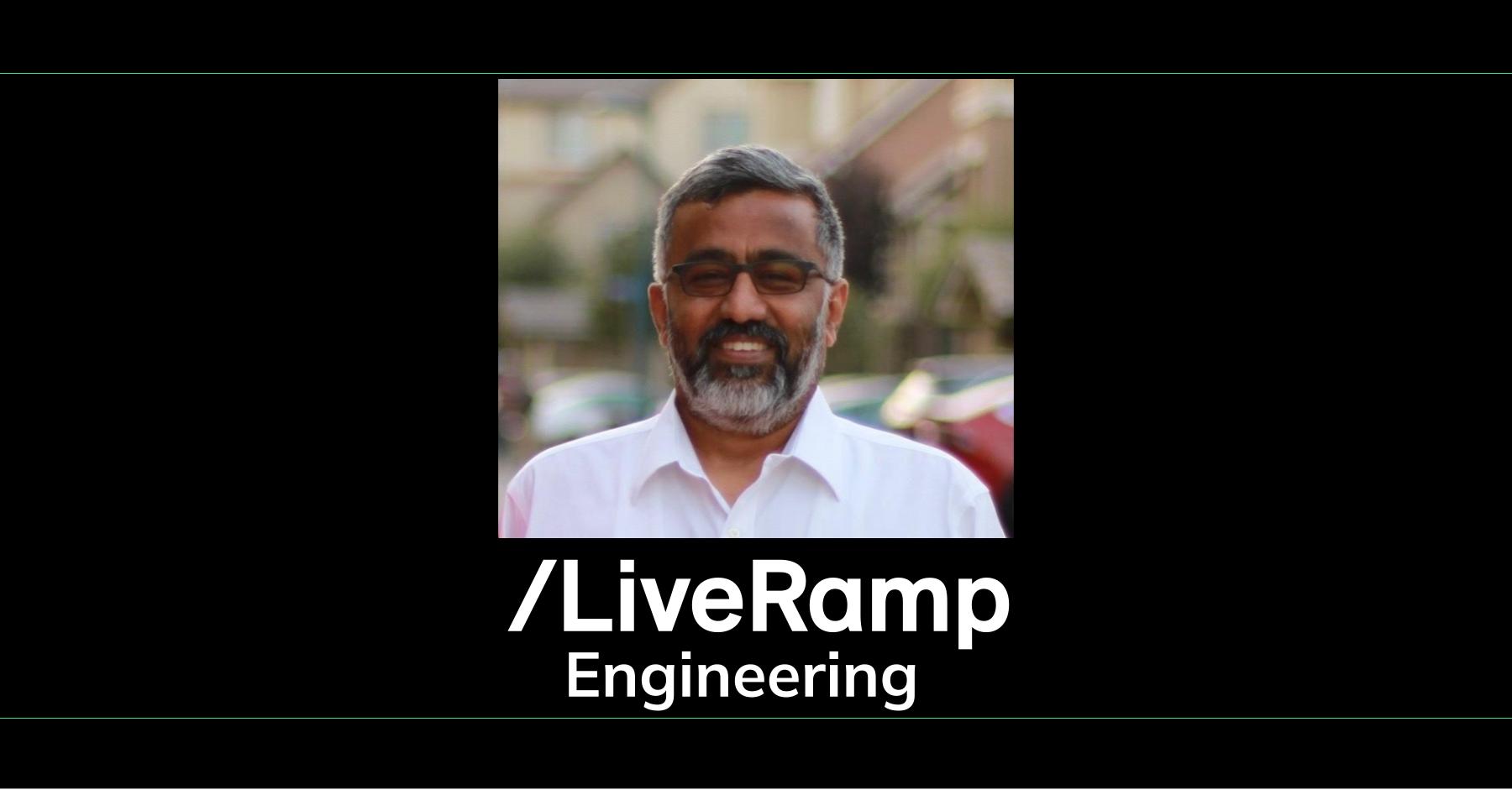LiveRamp Engineering is all about connections.
This is part two of a series of interviews with engineering thought leaders to share their unique perspectives in order to shed light on LiveRamp Engineering. Today, we connect with Kannan D.R., who is an Enterprise Data Architect, to gain some insights about his career path and what it’s like working at LiveRamp.
Kannan, what initially attracted you to engineering?
Starting from a young age, I was attracted to troubleshooting and solving problems whether it be in life or doing tasks. In high school, I was doing more reading than anything and, one day, I came across a feedback amplifier kit that was part of an Electronics magazine. I started assembling it and said to myself, “Wow, how does this work?” In the next week, I finished an entire semiconductor book and was completely intrigued by its concepts. It got me looking at technology in new ways. In college I started focusing on microprocessors and semiconductors including medical device simulations.
I was probably inspired by my small entrepreneurial town. The whole town is very inspiring and filled with small entrepreneurs and innovators. I’m proud to be the first in my family to graduate from college. I’m grateful to have inherited that natural curiosity that others had around me.
Can you describe your career journey for us please?

Since I had a Masters Degree in applied electronics focused on microprocessors at the time (~1993), it was difficult to find jobs in my areas of interest. So, I took a job selling fax paper which paid 1500 Indian rupees per month which translates into ~$18/month. Since I was selling fax paper, I wanted to start selling it to companies in the electronics industry to get my foot in the door with a tech company.
Next, I went into a sales and services engineering role in the medical equipment industry. After working about a year, I joined a division of the instrument company in India who imported products from the US. Their overhead costs were $2.5M and they needed to have a less expensive source as most of the medical institutions in India couldn’t afford that expensive equipment. So, I quit my job and started developing medical instruments on my own at age 23. I funded my company with revenue from electronic generators and inverters I designed because no funding was available for entrepreneurs at the time. I guess you could say that necessity was really the mother of invention.
I developed and demoed the products I created but didn’t know how to take my inventions to market so I crashed. I was way over my head. I got products working but had no sales experience.

Afterward, I moved into software. The industry then encountered the Y2K problem which created a hotbed for jobs in software.
Data was my new focus and I developed my own database in coding language C that could handle more sensitive data. Economy of scale became pervasive and new ideas came my way. I worked with PeopleSoft and other ERPs and moved to the US to work with an Indian consultant company where I worked on various, unique projects.
Next, I worked with a company which provided a large source of online residential mortgage loans for brokers. It was one of the first businesses who aspired to become a dotcom for the mortgage industry. The challenge was that they had archaic and cumbersome processes ingesting data in varying formats from spreadsheets that were so time consuming they left the company only a matter of hours to actually close loans on time. It was very slow and they needed a solution which I provided. Their 5 hour process was reduced to 15 minutes with my remediation. We grew the company from 50 employees to over 300. I witnessed the whole dotcom growth, played a crucial role and got compensated for it. It was a good opportunity to work directly with a CEO because I joined early, solved pain points and got to experience both the growth as well as the crash of dotcoms. It was a fantastic experience being in the middle of it all.
Soon thereafter, a Merger and Acquisition (M&A) opportunity came our way and Monster.com bought our consulting company. I got to play a key role in the merger activities and feel lucky to have been part of the process at such an early stage in my career. During the consulting phase of my career, I had the opportunity to work with all the current technologies and biggest booms when it was happening. One of them is Voice Over IP (VOIP). I had good exposure to VOIP with a data focus. It was the first company who offered online calls and a website to make and receive phone calls.
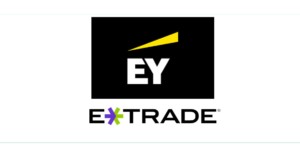
My next adventure was with a joint project of ETrade and Ernest and Young (E&Y) in the financial sector where the name of the game was scaling data.
Then, I had an opportunity at a startup in Oakland, California in a small printing company that had a good online presence for that era: printing work based on a website which was novel at the time. I played a bigger role rearchitecting their platform. It was 2003 and I wanted to help them out with a marketing tool. I developed a tool to connect web log data (non-identifiable) and ecommerce (identifiable) data to create analytics, customer tracking and 360 degree views which were just emerging. Ultimately, they were purchased for ~$50M by Deluxe. This experience would later be a catalyst for me joining LiveRamp.
In 2008, I joined a solar company (which is where I met Mohsin Hussain, our LiveRamp CTO) where we were, again, solving major data challenges. We had thousands of solar installations which, in order to use the data properly, required new processes and algorithms. We scaled a solution that was one of the world’s biggest solar data platforms at that time.

In 2016, I created a startup of my own again. I recognized a major gap in the device-to-device communication when working for the solar industry. Their main communication protocol (http) was not optimal. I worked on a MQTT broker forked out of an open source broker which we scaled and optimized for device-to-device and device-to-cloud communication. Within a mere 1.5 years, our company grew exponentially and received ~$11M in funding. Although I founded it and played the role of both CEO and Chief Architect growing it to a $60 million valuation, it outgrew me! The new board wanted a fancy CEO to take the company to the next level. I had a good exit but, after the fact, I asked myself, “Why did my own company outgrow me?”
In search of the answer I joined MIT and did a two year intense Technology Leadership program to find a sense of validation. Later, I ran into Mohsin again who invited me to join LiveRamp and help solve more big data problems. It was great to see him and I was happy to work with him once again.
What helped you decide to join LiveRamp engineering?
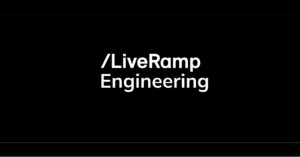
I joined LiveRamp to help solve a unique data problem – bringing stability back to such a large database. Later, I handed it over to Linover on my team and then stepped into this Enterprise Data Architect role. Although I’ve been in this role for approximately one year, it’s in the last six months that I’ve been much more actively playing an expanded role with the Architecture Leadership Group (ALG) helping solve bigger problems.
Can you expand upon the ALG?
Yes! I’m very pleased with the charter and accomplishments ALG has delivered so far. I must credit the LiveRamp Engineering leadership team with forming this strategic body of thought leaders. Tech Leaders came up with the idea of forming an ALG to break down silos of knowledge and visibility because there was so much specialization and siloed knowledge.
Mohsin and his Tech Leaders, Erin, Ramnik, Keng and Sean rallied around the idea immediately as our structure of having Chief Architects just wasn’t working. Chief Architects must have an understanding of the whole ecosystem which isn’t tenable given the specialization and complexity of our architecture.
It turns out that most startup company architects are founders. They come in on the ground floor and build every piece of an ecosystem. In creating the ALG, leadership appointed the right people who had specialized knowledge in our decentralized autonomous organization and we all came together into a fantastic group of specialists. We are getting things done more effectively and efficiently than anyone could have predicted. Leadership made the right choice and selected just the right people as members. There’s not much ego so that makes it easier.
I must share that, beyond the original members of ALG, there’s a magic ingredient. Her name is Lizzy and she’s our Technical Program Manager (TPM). At first, I wasn’t certain we needed a TPM and certainly thought a person in that role might get bored with such tasks as wordsmithing documentation for our group. I was wrong and realized her immense value within the first week of her being hired. She keeps us laser focused on what needs to happen now and what is needed for tomorrow methodically. She is absolutely objective and insightful.
Thanks to the formation of our ALG, previously siloed knowledge is now accessible and we’re able to connect the dots. My colleagues, Adam and Abhishek, are able to match problems with information allowing us to innovate and problem solve at a record pace. You can have the coolest technology but it’s only good if it’s benefiting our company and customers. We are solving the right problems, planning our next steps and reaching people and milestones unavailable previously. We keep marching on with Maxim on platform reinvention, Kamran on observability, Jason on Cloud runtime and Johan on security and compliance. Ten years from now, we’ll look back and realize that creating this engineering ALG will prove to be a pivotal decision for LiveRamp.
As Architects, we are finding elegant yet simple ways of solving problems. If it works for us, it should help others, too. These are ideas that should help our entire industry. That’s how we think at LiveRamp: what are we solving that will help others? I’m proud to be a part of a company with this belief system.
Please describe one of the types of interesting problems you are working on now.

Now, mainly my focus is ALG. LiveRamp is in a great position now with the fantastic combination of new people and long time, experienced employees which creates a pool of dynamic resources that can challenge every assumption, tap into innovative ideas and rethink previous schools of thought. It’s a great time to do big things. Change can really happen with this mix of talented people and limitless mind mapping! Otherwise, it would be much more difficult.
ALG’s formation and timing lets us rethink everything for the future: new tech as well as engineers. The value this group brings is industry transformational, creating disrupting tools and technologies (RedPanda, SingleStore distributed databases, Snowflake and Scylla). Partnering in this way will take us to the next level for future products.
What are you most proud of in your career accomplishments?
I’m really proud of the people I mentored during my career. For example, Linover and Senthil have worked with me for 15+ years and still want to work with me, which is an honor. I’m very proud to see people I’ve mentored thrive in their careers.

In reflection, I recently turned 50 years old and found that I was self-analyzing and asking myself, “What is my legacy? What’s next for me?” I realized I was overthinking it all just like a typical engineer.
I started measuring my life with my own custom yardstick. Through all of my creative phases and building two companies, only a few years of my career made sense to me. Innovation, creativity and doing good is all that counts. Transformational stuff that was useful for me, other people and my company is what rose to the top. That’s what made me happy. I determined that, for the rest of my life, I only want to spend time on those things that measure up to my personal yardstick. My measure is about impactful, tangible outcomes.
What advice would you give early career engineers?
Make sure your career and life is measuring up to what you value most. Find and build your own yardstick. Don’t work just for the salary or you won’t be happy. Follow your happiness.
My top three things for a satisfying job are:
-
- Defined responsibility: your responsibility is your boss
- Freedom to deliver on objectives
- An adequate budget to accomplish my goals
I can always find success if I have these things. I suggest others find their top 3 and stay true to them.
What’s some of the best advice you’ve ever received?
A good mentor of mine who has sincerely helped me in my career recently said, “Don’t react, just respond.” I took his advice and now just observe and respond.
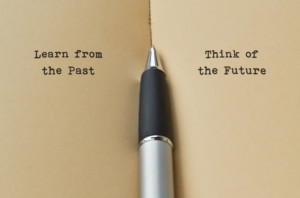
I’ve also realized that my whole life is based on an axis where failures and successes are pretty even and don’t mean that much.
I crashed my first start-up and then I did something better afterward. Going back to school for new insights at MIT, I started yet another company. Focusing on mapping failures and successes is futile. Ratios like that are not as critical to worry about as they should be treated equally.
Please describe a mentoring engagement you’ve enjoyed.
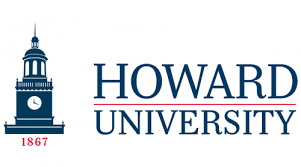
Recently, I was honored to be a mentor for a class of software engineers at Howard University. It was a very good experience and absolutely rewarding. It’s a great feeling to guide others toward innovation.
I currently mentor several CEOs at various startups and am on the board of advisors for an incubation startup program with investors. They are all rewarding experiences.
What’s your favorite thing about LiveRamp Engineering’s culture?
At the highest level of LiveRamp, our CEO, Scott, tells us to break down any barriers of bureaucracy to get things done. Our CTO, Mohsin, gives us room to try new ideas freely.
Our Senior Director of Infrastructure, Ramnik, fosters an environment of freedom and an action oriented mindset giving me the freedom to innovate. I get to simply go develop solutions. Freedom is amazing here! Who doesn’t want this kind of freedom? I can’t imagine anyone.
Two colleagues who are also ALG members, Abhishek and Adam, have worked here for over fifteen years yet they never get frustrated. Both are as motivated as a brand new engineer. They continue to want to keep solving the next problem. They keep other employees engaged, motivated and wanting to remain here at LiveRamp. They both have the, “Let’s go!” attitude. I’ve never seen that before. If LiveRamp can keep the spirit in them alive for so long, then LiveRamp is where I want to be.
If you were asked by a potential candidate why they should join LiveRamp, what would be your answer?
LiveRamp is an amazing place with amazing culture and as I mentioned earlier it is a great place to do the biggest transformation. We are in a conducive place to make the transformation with a great set of engineers that possess a very welcoming mindset. Jump on the fast train with us to be part of the biggest transformation of the era.
Soon, many LiveRamp employees will begin returning to the office occasionally. What do you enjoy about going to the office?

We started going into the office occasionally before we were encouraged to do so. After such a long time exercising social distancing, it’s energizing to be face to face with colleagues where we can solve problems faster. No Zoom call can light up a group of engineers with energy the way it’s done in person.
Lastly, given you live in the general vicinity of San Francisco, what’s your favorite part of living in the area?
We have great offices in many cities and some employees are fully remote.

I live outside of the San Francisco immediate area in a small, quiet town. I take morning walks with my lab, Red, which is when I get inspiration and new ideas.
I’m inspired and my goals are being met working at LiveRamp.
LiveRamp is a data enablement platform designed by engineers, powered by big data, centered on privacy innovation, and integrated everywhere.
Enabling an open web for everyone.
LiveRamp is hiring! Subscribe to our blog to get the latest LiveRamp Engineering news!
